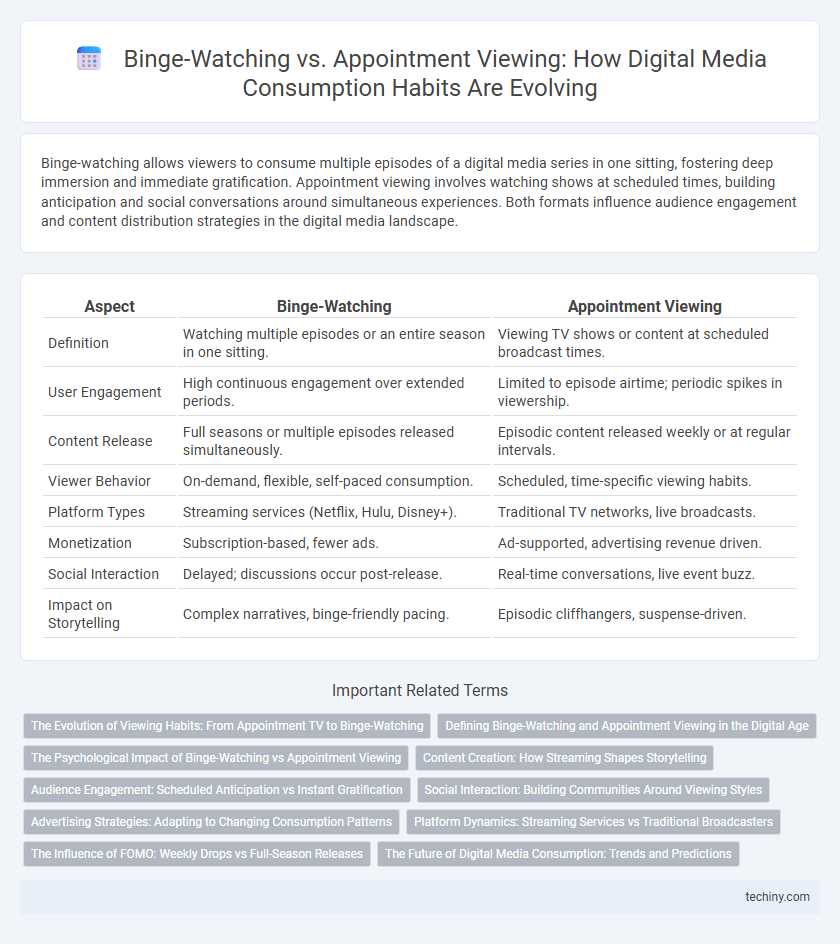Binge-watching allows viewers to consume multiple episodes of a digital media series in one sitting, fostering deep immersion and immediate gratification. Appointment viewing involves watching shows at scheduled times, building anticipation and social conversations around simultaneous experiences. Both formats influence audience engagement and content distribution strategies in the digital media landscape.
Table of Comparison
| Aspect | Binge-Watching | Appointment Viewing |
|---|---|---|
| Definition | Watching multiple episodes or an entire season in one sitting. | Viewing TV shows or content at scheduled broadcast times. |
| User Engagement | High continuous engagement over extended periods. | Limited to episode airtime; periodic spikes in viewership. |
| Content Release | Full seasons or multiple episodes released simultaneously. | Episodic content released weekly or at regular intervals. |
| Viewer Behavior | On-demand, flexible, self-paced consumption. | Scheduled, time-specific viewing habits. |
| Platform Types | Streaming services (Netflix, Hulu, Disney+). | Traditional TV networks, live broadcasts. |
| Monetization | Subscription-based, fewer ads. | Ad-supported, advertising revenue driven. |
| Social Interaction | Delayed; discussions occur post-release. | Real-time conversations, live event buzz. |
| Impact on Storytelling | Complex narratives, binge-friendly pacing. | Episodic cliffhangers, suspense-driven. |
The Evolution of Viewing Habits: From Appointment TV to Binge-Watching
The evolution of viewing habits reflects a shift from appointment TV, where audiences tuned in at scheduled times for shows like "Friends," to binge-watching enabled by streaming platforms such as Netflix and Hulu, offering entire seasons on demand. This transition highlights changes in content consumption driven by technological advancements and user convenience, leading to increased viewer control and engagement metrics. Data from Nielsen reveals that binge-watching sessions average three to four episodes in one sitting, reshaping advertising strategies and content release models in digital media.
Defining Binge-Watching and Appointment Viewing in the Digital Age
Binge-watching refers to consuming multiple episodes of a digital series consecutively, enabled by on-demand streaming platforms like Netflix and Hulu. Appointment viewing denotes scheduled broadcasts where audiences watch shows at a specific time, often live, typically associated with traditional TV networks such as NBC or HBO. The shift from appointment viewing to binge-watching reflects changing consumer preferences driven by digital technology and content accessibility.
The Psychological Impact of Binge-Watching vs Appointment Viewing
Binge-watching intensifies dopamine release, creating a feedback loop that can lead to increased screen addiction and diminished attention spans, while appointment viewing promotes self-regulation and anticipation, enhancing viewer satisfaction and emotional connection. Studies reveal that binge-watching often correlates with heightened anxiety and disrupted sleep patterns, unlike appointment viewing, which tends to foster social engagement and routine. The psychological impact largely depends on consumption patterns, with binge-watching potentially exacerbating mental fatigue and appointment viewing offering a more balanced, mindful media experience.
Content Creation: How Streaming Shapes Storytelling
Streaming platforms transform content creation by enabling binge-watching, encouraging serialized narratives with complex arcs that sustain viewer engagement over multiple episodes. Appointment viewing drives creators to develop episodic content with cliffhangers and timely relevance to capture live audiences and social media buzz. This dynamic reshapes storytelling structures, balancing immersive depth with immediacy to optimize audience retention and platform algorithms.
Audience Engagement: Scheduled Anticipation vs Instant Gratification
Binge-watching drives instant gratification by allowing audiences to consume entire series in a single session, boosting immediate viewer engagement and social media discussions. Appointment viewing fosters scheduled anticipation, creating communal experiences and sustained audience interaction over time. Both models shape digital media strategies by balancing immediate content access with prolonged audience loyalty and platform retention.
Social Interaction: Building Communities Around Viewing Styles
Binge-watching fosters virtual communities through shared immediate reactions on social media platforms like Twitter and Reddit, enhancing collective experiences despite physical distance. Appointment viewing encourages synchronized social interactions, creating real-time conversations and traditions around scheduled broadcasts, often leading to stronger local or live event-based communities. Both viewing styles leverage digital media tools to build distinct social networks, with binge-watching emphasizing on-demand engagement and appointment viewing preserving communal rituals through timed participation.
Advertising Strategies: Adapting to Changing Consumption Patterns
Binge-watching has transformed advertising strategies by emphasizing dynamic, targeted ads within streaming platforms, leveraging viewer data to personalize content and increase engagement. Appointment viewing retains value for live events and serialized shows, prompting advertisers to use real-time, event-specific campaigns and interactive commercials to capture audience attention. Brands are shifting budgets to hybrid models that integrate programmatic advertising for binge-watching alongside traditional time-slot buys in appointment viewing to optimize reach and effectiveness.
Platform Dynamics: Streaming Services vs Traditional Broadcasters
Streaming services dominate binge-watching by offering entire seasons on-demand, enabling viewers to consume content at their own pace. Traditional broadcasters rely on appointment viewing, scheduling episodes at specific times to build anticipation and shared audience experiences. The platform dynamics influence audience behavior, with streaming driving personalized, continuous consumption and broadcast prioritizing collective, time-bound engagement.
The Influence of FOMO: Weekly Drops vs Full-Season Releases
The influence of FOMO (Fear of Missing Out) significantly shapes viewer preferences between binge-watching and appointment viewing, with weekly drops fostering sustained audience engagement by creating anticipation and communal discussion. In contrast, full-season releases cater to binge-watchers who prioritize immediate gratification and uninterrupted storytelling, often intensifying emotional investment and social media buzz shortly after release. Streaming platforms leverage these release strategies to optimize subscriber retention and maximize viewer interaction metrics.
The Future of Digital Media Consumption: Trends and Predictions
Binge-watching continues to dominate digital media consumption with streaming platforms like Netflix and Disney+ reporting increased user engagement through entire-season releases. Appointment viewing experiences a resurgence driven by live events and interactive content on platforms such as Twitch and YouTube Live, fostering real-time audience participation. Emerging trends predict hybrid models integrating binge and appointment strategies, enhanced by AI-driven content recommendations and personalized viewing schedules.
Binge-watching vs Appointment Viewing Infographic

 techiny.com
techiny.com